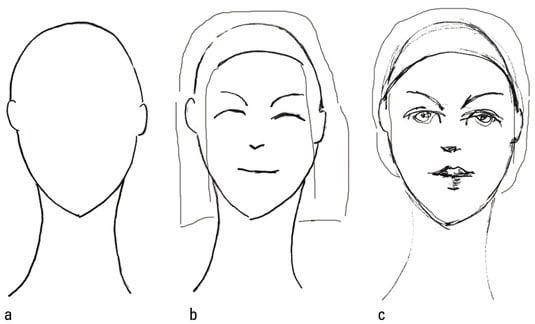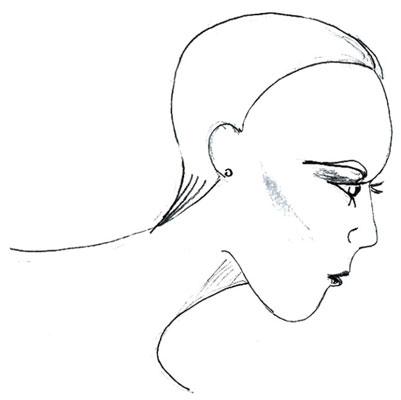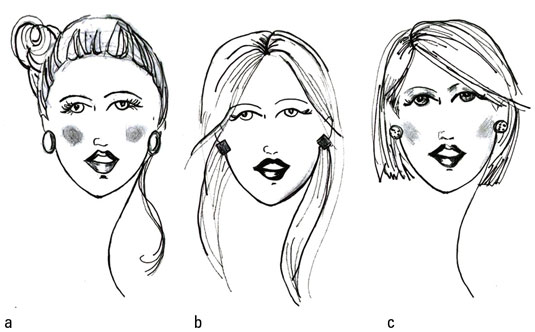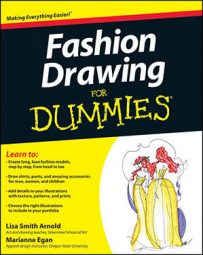Hair shouldn’t be the main focus in fashion illustration. It should convey a mood without overpowering the most important part of fashion illustration — the clothes and accessories. To create gorgeous hair and avoid the mistakes found in lesser fashion drawings, keep these three basic hair facts in mind:
-
Hair grows out of the head. This point may sound obvious, but many people tend to draw hair that’s contained within the original oval they sketch for the head. Hair grows out of and extends beyond the head.
-
Hair falls across the face and head. Again, this fact may sound obvious, but many illustrators draw hair coming from the outside oval of the head. Hair grows from your forehead, temples, and the sides of your head, so it covers part of the oval that makes up the face.
-
The hairline follows the natural contours of the head. A delicate oval head shape requires a hairline that’s somewhat different from the hairline of a big guy with a square head.
Keep things natural with a curving hairline
Hair grows out from the hairline, which forms over the forehead and temples. Everyone’s hairline is different, but it always follows the natural contour of the forehead. Like the hairstyle in general, the hairline shouldn’t be a focal point on a fashion illustration; it should look natural.A hairline that’s too low looks Neanderthal, and one that’s too high leaves too much empty forehead. To mimic a person’s natural hairline, use a gentle curve that follows the shape of the head. Keep in mind that fashion figures are known for having elegant and high foreheads.
Here’s how to draw a curving hairline on a front-facing figure:
-
Draw a head.
-
Sketch out facial features on your face.
If necessary, use a face grid to help you place the eyes and other features in the right places.
-
Mentally divide the space between the eyes and the top of the head into thirds. A little more than a third of the way down, draw the beginning of a curving hairline. To outline the hair area, add another line above the head line, going down and around the sides of the head.
This is how you cut into the face area and add hair to the outside of the original sketched oval.
Be careful where you start your hairline. Allow some distance between the top of the head and the start of the hairline; otherwise, you'll have a fashion figure with scanty hair.
To show the outline for an updo, draw the hairline curve to meet the top of the ears and round out the bottom of the hair a little blow the ears. The curve tapers and narrows as it approaches the ear. It should meet at the top of the ear and shouldn’t ever go over the ear.

If your fashion figure is in profile, follow the preceding steps but continue the curve of the hairline to the top of the ear and then behind the ear on the neck. Fill in the hair at the side and back of the head and behind the ear.
You see more of the back of a fashion figure’s head when looking at a profile, which means you have to include more hair in your fashion figure profiles.

Deliver a good parting line
A part is a line that determines the hair shape and direction in which the hair falls. Every hairstyle starts with a part (or lack thereof); you can’t begin to draw a hairstyle until you establish whether your model will have a side part, a middle part, or no part at all. Part placements, like hairstyles, convey different looks that may be more appropriate for a particular fashion style.You can part hair in tons of different ways (some of which are pretty extreme), or you can avoid parts completely. If you stick with the following three parting styles that are commonly used in fashion illustration, your figures will always look stylish:
-
Hair pulled back into a topknot with no part: Even though you don’t use a part with this option, it’s a classic model hairstyle. This is a great casual look that keeps hair off the shoulders and shows off clothes beautifully.
-
Hair parted down the center: A center part, shown in the middle below, works for long or short hair.
-
Hair parted to one side: A side part is sexy yet sophisticated. It works for long or short hair.
To draw a part, first draw a fashion figure’s head, adding a hairline across the forehead. Then follow these guidelines:
-
For a center part: Draw a center line that goes from the middle of the top of the head down to the curve of the hairline.
-
For a side part: Draw a line that’s slightly off center that goes from the middle of the head down to the curve of the hairline.


